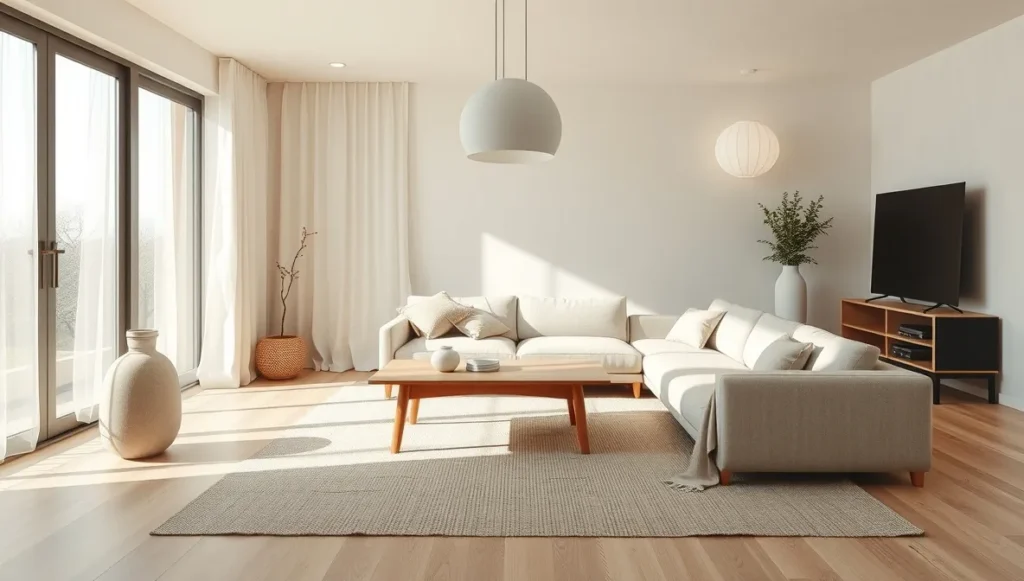- The Unexpected Magic of Boho Scandi: Why This Fusion Style is Taking Over Modern Homes - September 2, 2025
- Japandi Design: Why This Japanese-Scandinavian Hybrid Has Taken Over My Client Projects - September 2, 2025
- The Real Story Behind Transitional Interior Design: Why It Actually Works - September 1, 2025
Table of Contents
You know that feeling when you walk into a space and immediately feel calmer? Your breathing slows down, your shoulders relax, and suddenly the world feels a little less chaotic. Last month, I watched this exact transformation happen when my client saw her finished living room. She just stood there, taking it all in, then quietly said, “I didn’t know my house could feel this peaceful.”
Dramatic? Maybe. But also completely genuine. Don’t believe me? Check it out..
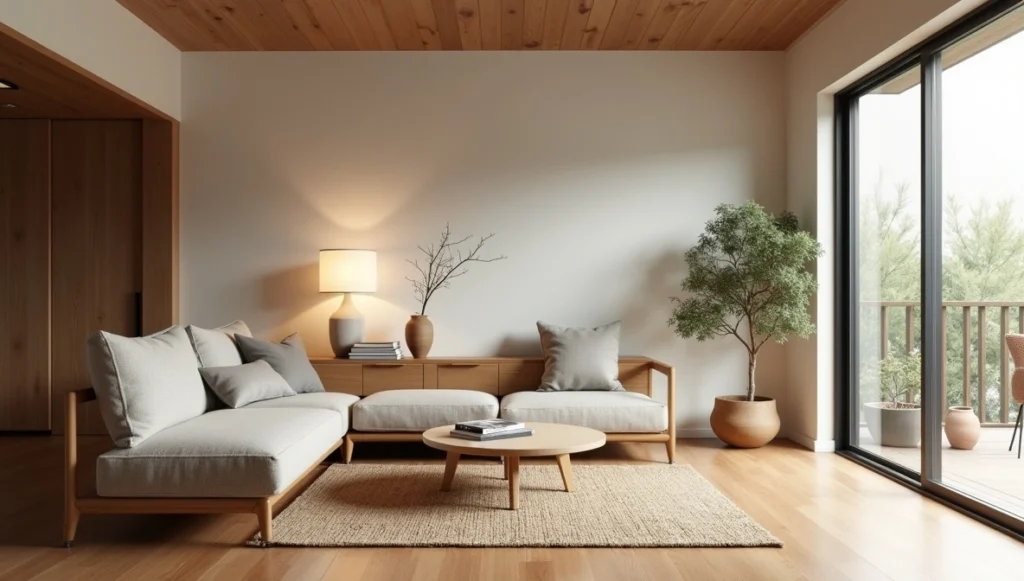
The Story Behind Japandi (And Why It Actually Works)
Okay, so “Japandi” sounds like something a marketing team dreamed up over too much coffee. And honestly, the name is a bit cringey – it’s literally just “Japanese” + “Scandinavian” smooshed together. But here’s the thing: this design approach has legs because it solves a real problem.
We’re all drowning in stuff. Our homes are cluttered, our minds are scattered, and we’re desperately seeking spaces that feel like sanctuaries instead of storage units. Japanese design has this beautiful concept called “ma” – it’s about negative space, about what you DON’T put in a room being just as important as what you do. Scandinavians, meanwhile, have mastered the art of cozy functionality. They know how to make a space feel warm and lived-in without it being messy or overwhelming.
Put these two philosophies together? Magic happens.
What Actually Makes Japandi Work
It’s About Editing, Not Emptying
People see minimalist spaces and think “stark” or “cold.” But there’s a huge difference between empty and edited. A few years back, this client brought me photos of completely bare rooms – white walls, maybe one piece of furniture, nothing else. “I want this exactly,” she insisted.
Except when we really talked about it, what she craved wasn’t emptiness. She wanted calm. She wanted to come home and feel her stress melt away, not like she was staying in a hotel.
Good Japandi spaces have soul. They just don’t shout about it. Maybe it’s a single piece of pottery that catches afternoon light perfectly. Or that wooden bowl your grandmother used for fruit. The space breathes, but it also lives.
Choose Things That Get Better with Time
Here’s something most people don’t think about: the best materials actually improve as you live with them. Solid wood develops those little dings and scratches that tell stories. Linen gets softer every time you wash it. Even leather gets more beautiful as it wears.
Recently worked on a kitchen where the homeowner wanted quartz everywhere because “it’s indestructible.” But we ended up with these gorgeous thick wood counters instead. Sure, they need attention. Oil them every few months, sand out the occasional stain.
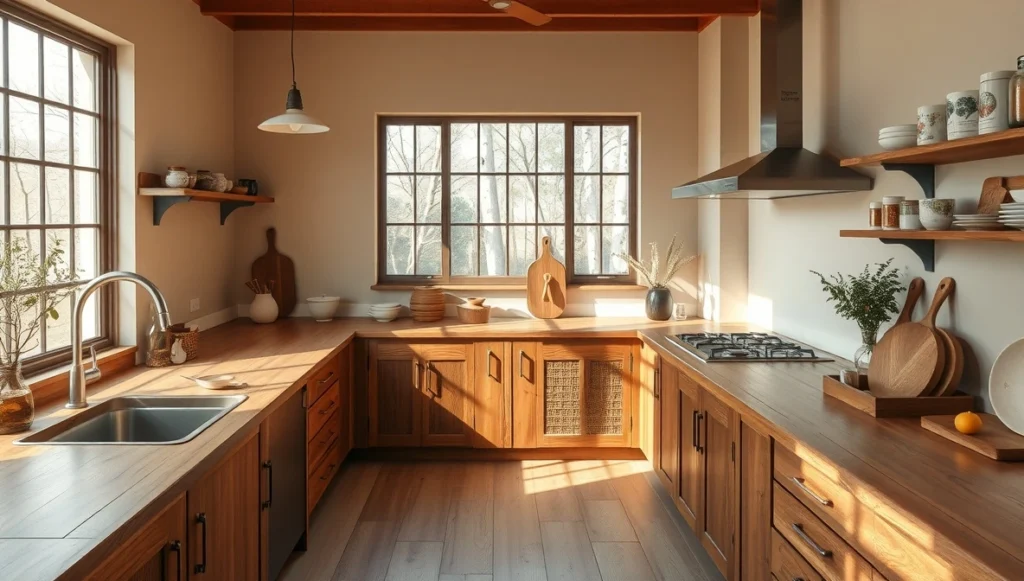
The Quietest Colors Are Often the Most Powerful
Think about places that made you feel instantly peaceful. Maybe that foggy beach morning. The forest right before sunrise. Sun-bleached wood from a childhood vacation. These moments don’t scream for attention, but they stick with you.
That’s the color story here – what some of us call the “whisper palette.” Whites that feel warm instead of stark. Grays with hints of brown or green. The faintest sage that reminds you of dried herbs. Sometimes deeper tones appear – charcoal or rich chocolate – but they anchor rather than dominate.
Making It Work Room by Room
Room by Room: What Actually Works
Living Rooms Worth Living In
Low furniture just makes sense here – not because some design rule says so, but because it opens up the whole space. When everything sits closer to the ground, even a cramped apartment feels bigger.
Sofas need to be genuinely comfortable though. Deep enough for curling up with a book, firm enough that you’re not fighting to get out of them. Linen covers work great because they actually look better a little wrinkled – no stress about keeping everything pristine.
Storage is tricky. Built-ins are fantastic if you can swing them, but wooden boxes work just as well for hiding the random stuff that accumulates. The trick is making sure nothing screams “look at me!”
Lighting makes or breaks these spaces. Overhead fixtures feel harsh and institutional – like you’re in an office instead of home. Table lamps, floor lamps, candles scattered around create this warm glow that makes everyone want to stick around longer.
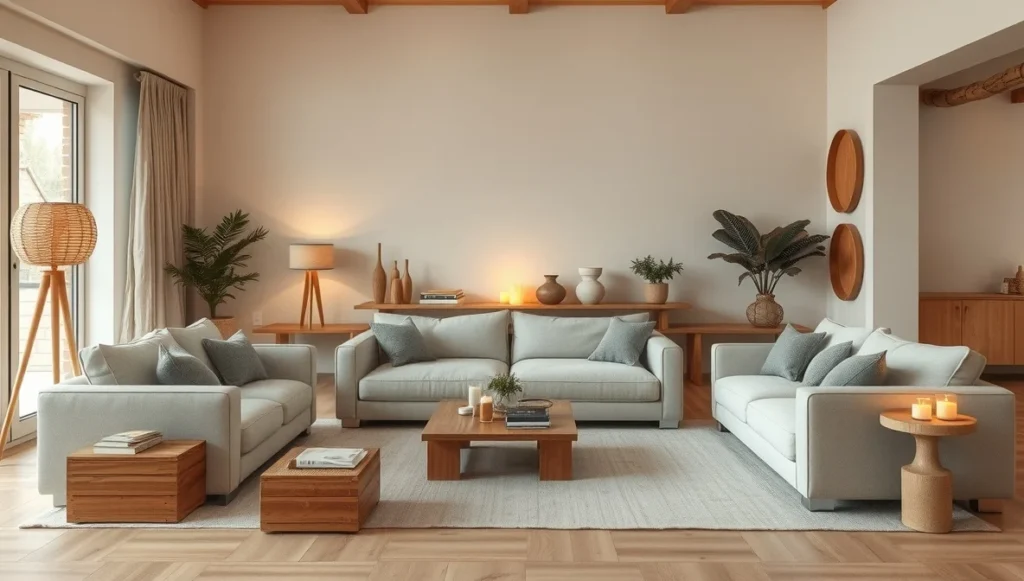
Kitchens That Work for Real Cooking
Flat cabinet doors are pretty much non-negotiable – all those raised panels and decorative details just collect grease and look busy. Wood looks gorgeous, but matte painted finishes hide fingerprints better if you’ve got kids.
For hardware, either go completely hidden (those push-to-open mechanisms) or super simple wooden knobs that feel good when you grab them. Chrome and brass just feel wrong here.
Open shelving only works if you’re honestly going to keep it looking good. Display the dishes you actually use and love, not random stuff that looked cute at the store. Half-empty shelves beat cluttered ones every time.
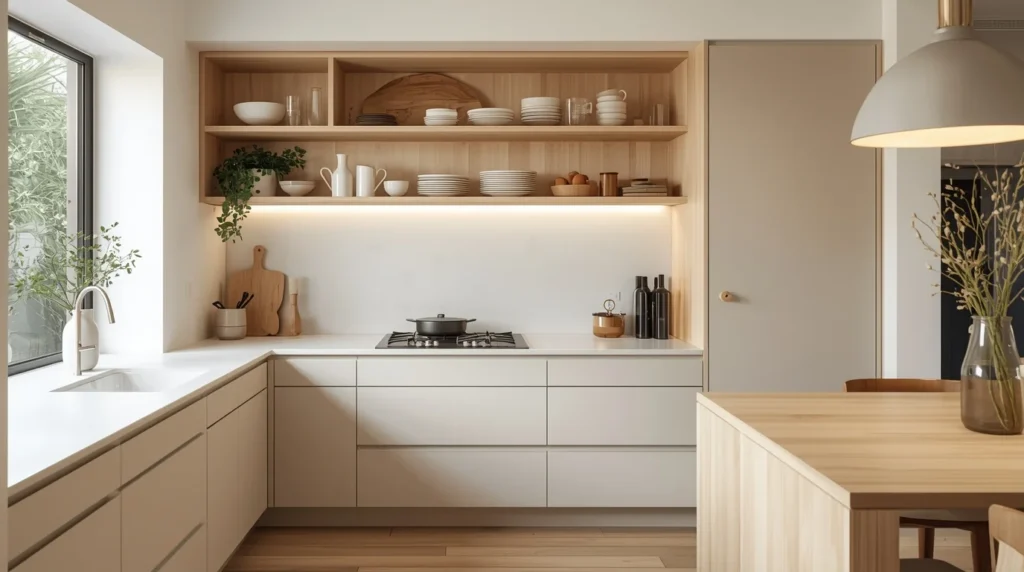
Bedrooms for Actually Sleeping
Platform beds make sense because they don’t visually eat up floor space. Wood frames age beautifully, but honestly, even a simple upholstered frame works if the lines are clean.
Bedding should feel like a luxury hotel – crisp cotton or soft linen in whites and pale grays. One throw blanket for texture, maybe one extra pillow, but don’t go crazy with the decorative stuff. You want to crawl into bed, not rearrange a display.
Keep nightstands simple. Lamp, book, glass of water, small dish for jewelry. That’s it. Everything else goes in drawers or gets banished to the closet.
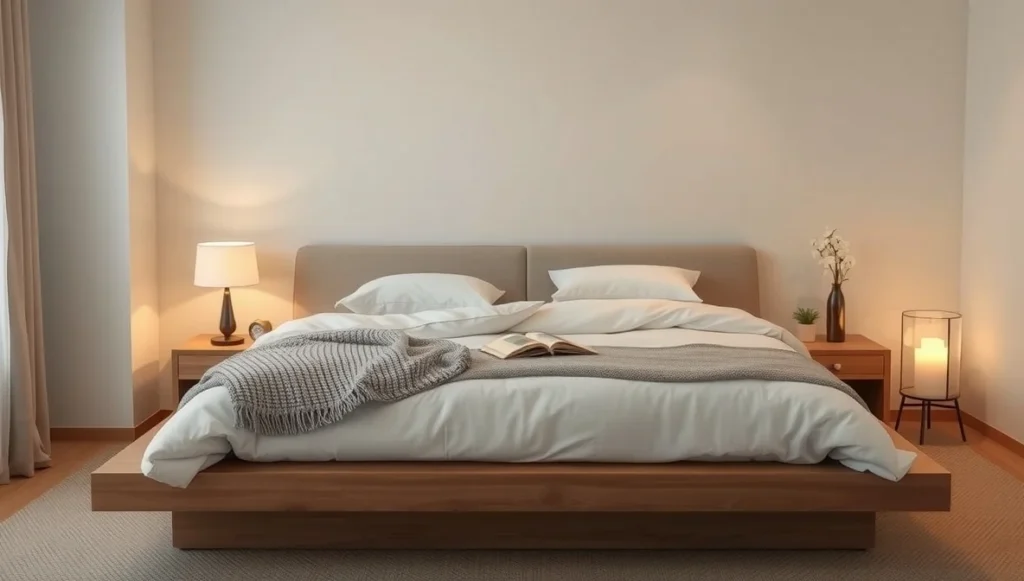
Dining Spaces That Encourage Lingering
Tables should be substantial enough to anchor the room but simple enough to showcase beautiful food and conversation. Wood with visible grain tells a story, but clean-lined designs work too. The key is choosing something that feels permanent, not trendy.
Seating can mix materials – wooden chairs with linen cushions, or a wooden bench paired with upholstered chairs. Comfort matters because the best meals unfold slowly.
Lighting over dining tables requires special attention. One beautiful pendant light in natural materials – woven rattan, ceramic, or wood – creates intimacy without dominating. Skip the chandelier entirely.
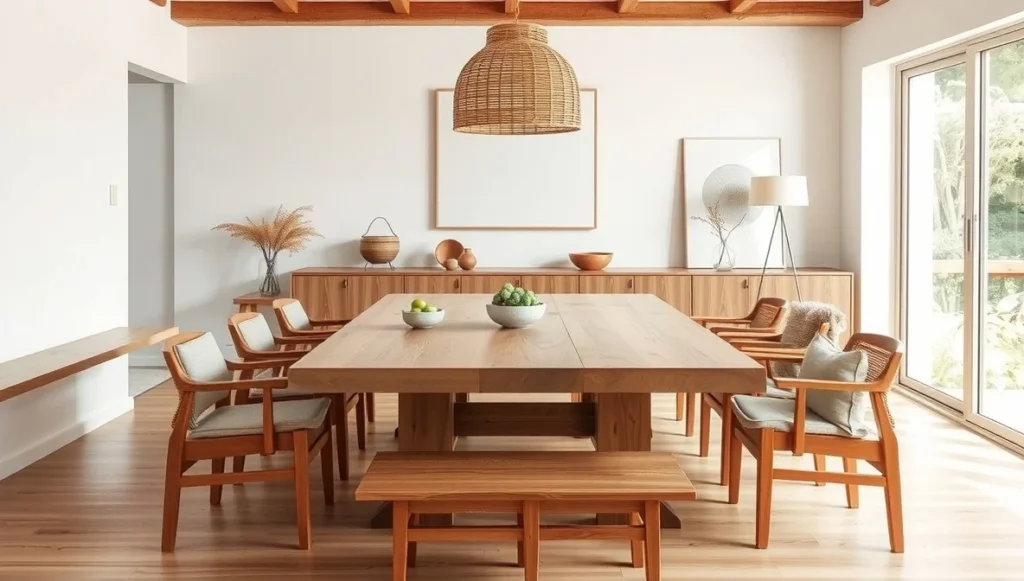
Home Offices That Support Focus
Working from home demands spaces that promote concentration without feeling sterile. Solid wood desks show beautiful grain while hiding cable management systems. Position near windows when possible, supplementing natural light with adjustable task lighting.
Organization is everything, but storage should disappear into beautiful solutions. Wooden file cabinets, built-in shelving, ceramic containers for supplies – everything needs a designated place, but that place should contribute to the room’s overall aesthetic.
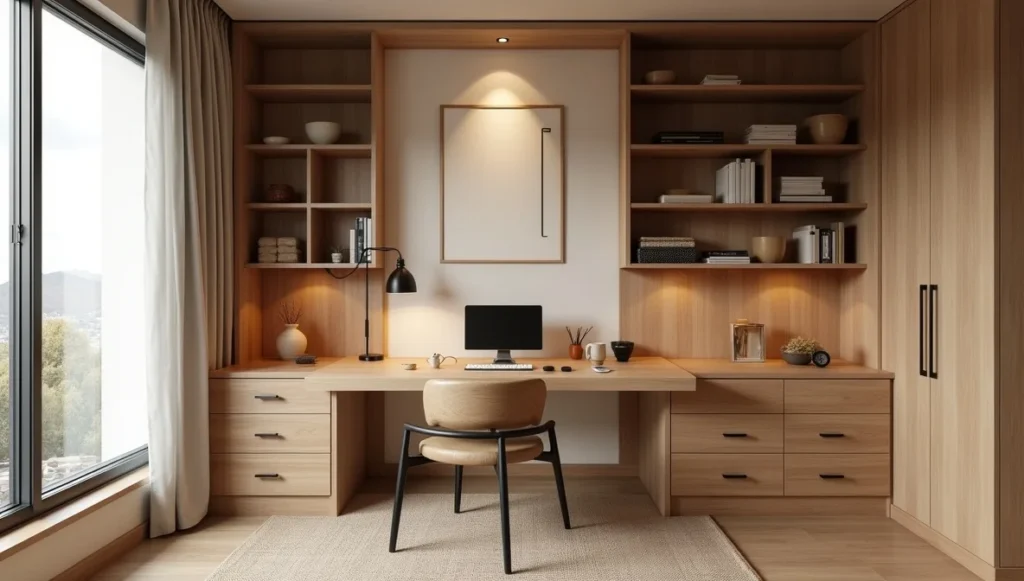
Bathrooms Worth Lingering In
Natural materials transform utilitarian spaces into retreats. Wooden vanities (properly sealed for moisture), stone vessel sinks, bamboo accessories – these elements make daily routines feel more intentional.
Mirrors should have minimal frames or none at all. Lighting should be soft and flattering – think wall sconces rather than harsh overhead bulbs. Even practical items like towels and toiletries can contribute to the aesthetic when chosen thoughtfully.
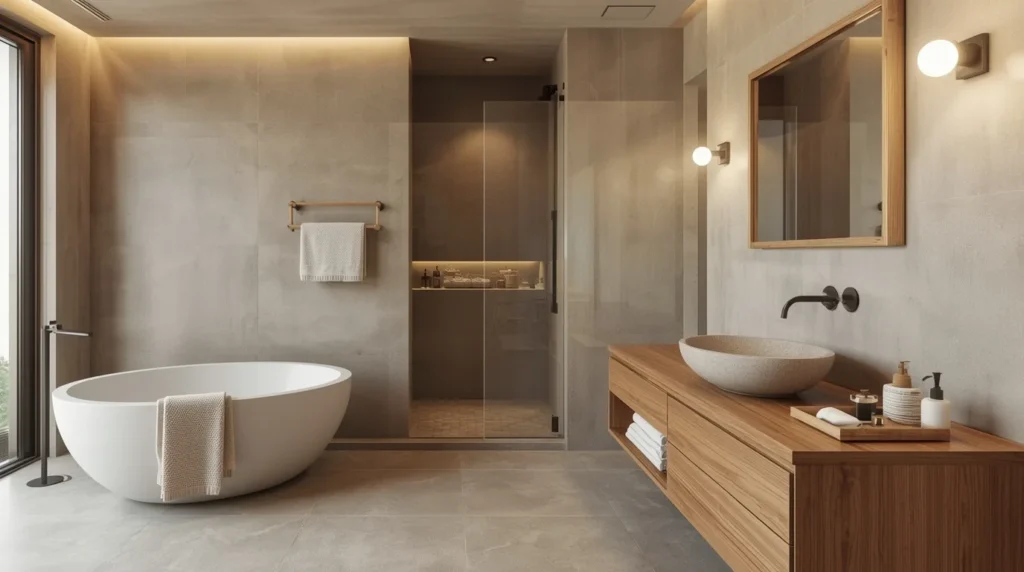
Entryways That Set the Tone
First impressions happen in entryways, and Japandi approaches create immediate calm. Simple wooden benches provide seating for shoe removal – a Japanese custom that keeps homes cleaner and more peaceful.
Storage should be thoughtful but not obvious. Built-in cubbies or beautiful baskets contain everyday items without visual chaos. Hooks should be minimal and purposeful, perhaps integrated into wooden panels that serve as both function and art.
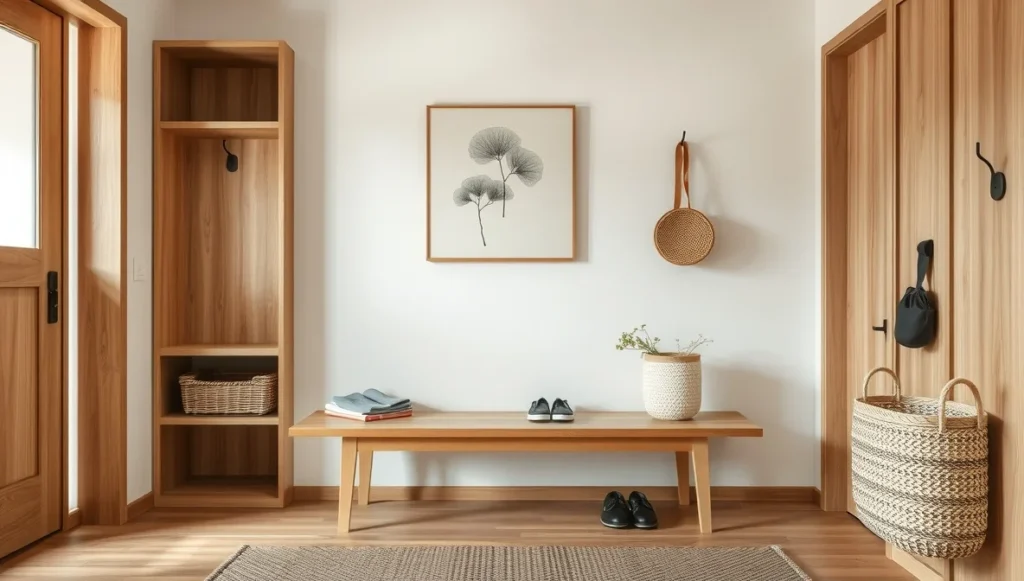
Kids’ Rooms (Yes, It’s Possible)
Children’s spaces require compromise between minimalist ideals and childhood realities, but it absolutely can work. Natural wood furniture grows with kids – simple bed frames, plain dressers, study desks that transition from art station to homework space.
Storage becomes crucial. Wooden toy boxes, built-in cubbies at child height, woven baskets for quick cleanup – these maintain order without harsh edges or bright plastic eyesores. Rotate toys seasonally so only current favorites stay visible.
Color comes through textiles and artwork rather than painted walls or themed furniture. Natural linen curtains, organic cotton bedding, perhaps one beautiful mobile or wall hanging. Even children benefit from spaces that promote rest and focus.
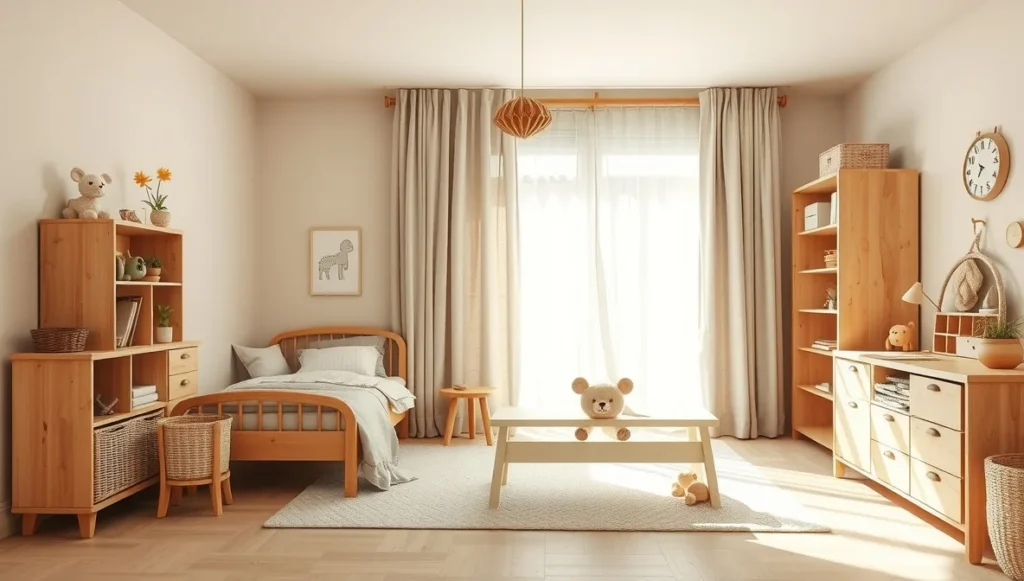
Common Mistakes (That I’ve Definitely Made)
Buying Everything at Once
Early on, clients would get excited and want to redo entire houses in one shopping spree. Doesn’t work. These spaces need to develop organically – live with basics first, then slowly add pieces that genuinely speak to you. Otherwise you end up with a bunch of stuff that looks right individually but doesn’t feel cohesive.
Prioritizing Pretty Over Practical
Learned this one the hard way. That gorgeous linen sofa that can’t handle pizza night with kids? The beautiful wooden dining table that shows every water ring? Design has to work for real life, or it’s just expensive decoration.
Getting Impatient
Good spaces take time to develop. You live with something for a while, notice what’s missing, add one thing, live with it some more. It’s not very Instagram-friendly, but it creates homes that actually fit how you live.
Why This Actually Matters Right Now
We’re all overwhelmed. Our phones never stop buzzing, our schedules are packed, and somehow our homes became storage units instead of retreats. This whole approach offers something different – spaces that actively help you decompress instead of adding to the chaos.
Clients mention sleeping better, feeling less scattered, actually enjoying time at home instead of constantly wanting to escape. One woman told me she started looking forward to doing dishes because her kitchen finally felt peaceful instead of stressful.
People tell me their sleep got better, their minds feel clearer, they actually enjoy their morning routines now. One woman mentioned that making coffee became her favorite fifteen minutes of the day. Not because she added some elaborate ritual, but because her kitchen finally felt like a place worth lingering in.
This whole approach keeps teaching me something important: having less stuff doesn’t mean living with less joy. Sometimes it’s the complete opposite.
